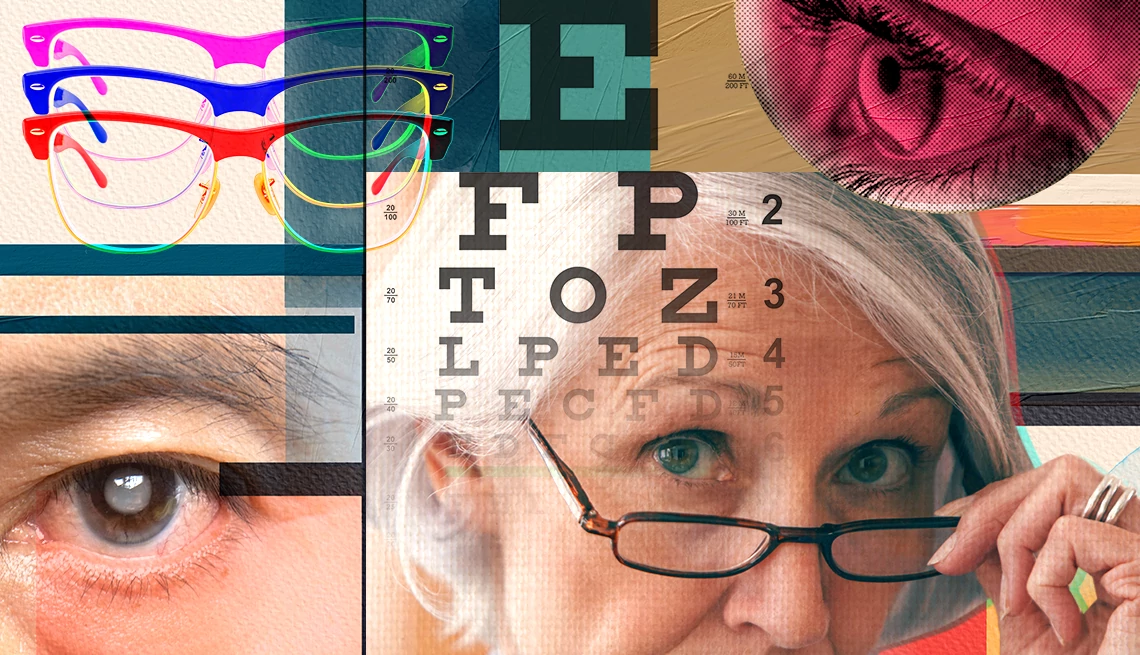AARP Hearing Center


Choose Your Next Age-Related Eye Condition Story:
- What to know about cataracts
- What causes blurry vision in one eye
- Sudden blurry vision in both eyes
- What to do about peripheral vision loss
- Flashes and flickering in the eyes
- Could you have light sensitivity?
- What is diabetic retinopathy
- When are dry irritated eyes a sign of thyroid disease?
- Eye floaters, causes, symptoms and treatment
As we age, we can develop a wide range of issues that affect our eyes. In fact, adults aged 60 and older account for the majority of blindness cases worldwide. The top culprits? Age-related macular degeneration, cataracts, glaucoma and diabetic retinopathy.
The good news is that you can stay ahead of these issues by being aware of the warning signs of age-related eye problems and scheduling regular eye exams, as recommended by the American Optometric Association.
In this guide, we’ll break down common eye health problems, their symptoms and how to treat them. You’ll also find tips to keep your vision sharp and protect your eyesight as you age.
Recognizing symptoms of eye disease
As we age, our vision naturally begins to weaken. According to the Cleveland Clinic, changes can start as early as your 40s, with decreased tear production being one of the first signs. Over time, proteins in the eye's lens may break down, leading to cataracts, while the vitreous — a gel-like substance in the center of the eye — can shrink, resulting in floaters or even a more serious condition called retinal detachment.
Eye conditions can also pose safety risks, such as an increased likelihood of falls or accidents. Additionally, eye exams can sometimes reveal other underlying health conditions. These include issues like aneurysms, cancer, diabetes, heart disease, high blood pressure, multiple sclerosis, vitamin A deficiency, strokes and tumors.
Causes of eye conditions
A lot of factors can lead to vision problems, and some are more obvious than others. For example, a lack of nutritious foods in your diet, smoking, diabetes, high blood pressure, and skipping sunglasses on sunny days can all take a toll on your vision.
But it’s not just about lifestyle. Genetics play a big role too — your DNA shapes how your eyes develop and work, and changes in your genes can lead to conditions like color blindness. Sometimes, differences in how your eyes formed as a fetus or during childhood can also set the stage for problems later in life.
Environmental factors matter as well. Too much exposure to UV light, dust, or even the wrong humidity and temperature can contribute to eye issues. Then there are infections. Bacteria, viruses, fungi, and parasites can either attack your eyes directly or spread from other parts of your body.
Other chronic conditions, like Type 2 diabetes or thyroid disease, can also make your eyes more vulnerable. Past injuries might leave lasting effects, increasing your risk for future problems. And sometimes, the cause is simply unknown — what scientists call “idiopathic.”
No matter the reason, understanding these factors can help you stay ahead of potential issues and protect your vision.
Symptoms of age-related eye diseases
Many people with age-related eye diseases don’t notice symptoms in the early stages. But when symptoms do show up, they can look different depending on the condition. Common ones include:
- Cloudy or blurry vision
- Discomfort or burning
- Too many or too few tears
- Seeing spots or flashes of light
- Sensitivity to light
- Difficulty distinguishing colors
- Tunnel vision



































































More From AARP
Vision Health: Understanding Eye Tests and Diagnoses
Regular eye exams can help prevent blindness and detect other health issues
Vision Problems Raise Risk of Falls
Even mild problems can affect posture and gaitWhat Your Eye Color Can Say About Your Health
Plus, 8 types of changes in eye color that indicate problems